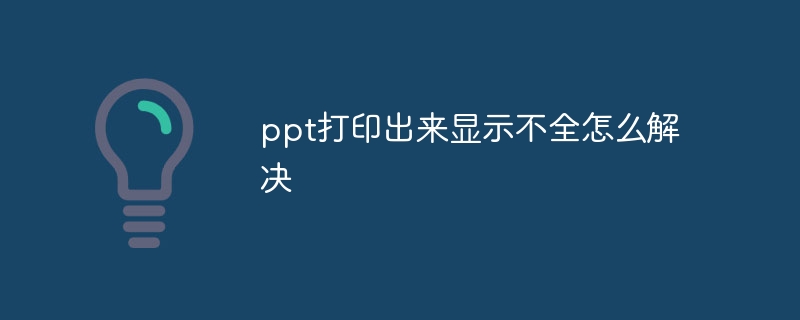Home >Common Problem >How to solve the problem of incomplete display when printing ppt
Solution to incomplete display when ppt is printed: 1. Check the page settings to ensure that the page size matches the printing paper size; 2. Adjust the zoom ratio and try different zoom ratios until it can be seen in the print preview Complete slide content; 3. Adjust the size of the text box, select the text box, and then drag the border to adjust the size to ensure that the text can be fully displayed on the printed page; 4. Optimize the picture resolution and use image editing software to edit the picture. Adjust the resolution to a size suitable for printing; 5. Print preview, use print preview to check whether the PPT content is fully displayed.

The operating environment of this tutorial: Windows 10 system, DELL G3 computer.
Microsoft PowerPoint is a commonly used slide production and presentation software. Whether in school, workplace or daily life, we often need to use PPT to convey information or display content. However, when we prepare to print PPT, we sometimes find that the content of the printed slides is incomplete, which causes us trouble. Here are some possible causes of this problem, as well as some solutions.
1. Possible reasons:
1. Incorrect page settings: Before printing PPT, we should ensure that the page settings are correct. Occasionally, we may have changed the page size without the print settings adjusting accordingly, causing the content to be truncated when printing.
2. Incorrect scaling: If we do not set the scaling correctly, the printed PPT content may exceed the page range. This may result in parts of the content not being printed, or being compressed during printing.
3. The text box is too small: If we use a text box that is too small in PPT, the text content may be truncated or cannot be displayed completely. This is a common problem, especially when designing text-heavy slides.
4. High-resolution pictures: If we use high-resolution pictures in PPT, and the printer has a lower resolution, the picture may not be displayed completely. This is because printers cannot accurately reproduce the details of high-resolution images.
2. Solution:
1. Check the page setup: Before printing, we should check the page setup and make sure the page size matches the printing paper size. This can be adjusted in the "Page Setup" option of PPT. Make sure the Paper Size option matches the actual paper size you are printing on, and set the correct margins.
2. Adjust the zoom ratio: Correctly setting the zoom ratio can ensure that the PPT content is fully displayed on the printed page. We can try different zoom ratios until we can see the full slide content in the print preview.
3. Resize the text box: If the text in your slide is cut off or doesn't fit in its entirety, we can.
4. Optimize image resolution: If we use high-resolution images in PPT and the printer has a lower resolution, we can try to optimize the image resolution. You can use image editing software to adjust the resolution of the picture to a size suitable for printing to ensure that the picture can be fully displayed.
5. Print preview: Before printing, we should always use print preview to check whether the PPT content is completely displayed on the printed page. If we find that some content is cut off or cannot be displayed in its entirety, we can make adjustments as needed.
Conclusion: Incomplete display of printed PPT may be caused by incorrect page settings, incorrect zoom ratio, too small text box or high-resolution pictures, etc. By checking the page settings, adjusting the zoom ratio, adjusting the text box size, and optimizing the image resolution, we can solve this problem and ensure that the printed PPT content is fully displayed on the paper.
The above is the detailed content of How to solve the problem of incomplete display when printing ppt. For more information, please follow other related articles on the PHP Chinese website!